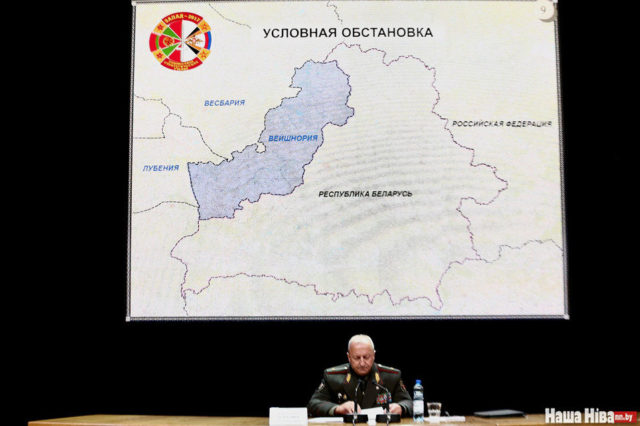
Zapad 2017 Plan Reflects Religious and Ethnic Factors, Not Just Geopolitical Ones
Publication: Eurasia Daily Monitor Volume: 14 Issue: 105
By:

The upcoming Zapad 2017 joint exercise by Russian and Belarusian troops in Belarus has sparked concerns that it may be used by Moscow either to carry out a hybrid revolution in Belarus—along the lines of what Vladimir Putin did in Crimea in 2014—or to put new pressure on Ukraine, Poland and the Baltic countries. Minsk has sought to downplay those fears by inviting observers from these countries and others and insisting that all Russian troops will be withdrawn from Belarusian territory when the exercise is completed at the end of September (Interfax, July 17; Belta, August 29). But plans for the exercise, as announced by the Belarusian General Staff, could add to nervousness not only in Belarus itself but among neighboring countries as well.
Belarusian paper Nasha Niva reports that those who planned the exercise created notional “enemy” territories that generally follow the borders of existing countries but also divide them and Belarus in particular along ethnic and religious lines. This seems to indicate that those ethnic and religious divisions, and not the political ones that emerged with the restoration of the independence of the three Baltic countries and the acquisition of independence by Belarus and Ukraine in 1991, play a far larger role in the thinking of Belarusian and Russian defense planners. The impact of such strategic thinking could prove deleterious to overall regional stability (Nasha Niva, August 29).
According to the Belarusian newspaper, Belarusian and Russian defense planners have created three notional “enemy” regions against which the joint exercise will be directed. These include “Luben” (composed of the northeastern portion of Poland and the southwestern part of Lithuania, i.e., the so-called “Suwałki corridor), “Vesbariya” (within which are the remainder of Lithuania and the central part of Latvia), and, most provocatively of all, “Vayshnoria” (embracing the northwestern portions of Grodno, Minsk and Vitebsk oblasts, which are all part of modern-day Belarus and are populated by the largest concentration of the country’s Roman Catholics). Thus, on the map issued by the defense planners, which Nasha Niva features in its reporting, the Republic of Belarus itself is shown in “a truncated form” (Nasha Niva, August 29).
In both Russian and Western defense exercises, it is common practice to invent “enemy” regions to avoid offending existing states by naming them directly. But three things make the Zapad 2017 case more serious in this regard than is normally true. First, by playing up ethnic and religious factors relative to political ones, this wargame plan appears to underscore Vladimir Putin’s oft-expressed view that many of the post-Soviet states are not real (i.e., their borders were “artificially” set) and therefore not deserving of the respect that countries normally accord to one another. That attitude lies behind what he has done in Georgia, Ukraine, Moldova and now, quite remarkably, in Belarus—which is supposed to be his closest ally as part of the Russian-Belarusian Union State.
Second, by combining land from various countries—in this case, Poland, Lithuania and Latvia—into one “enemy” state, the Russian and Belarusian defense planners have implicitly suggested that Moscow would be prepared to carve up these states at some future point if it reintegrates them under central Russian control. These western neighbors of Russia have to take that sort of threat seriously; but doing so could lead them to make statements or even take actions that might put them at odds with their Western allies, thus isolating them from the North Atlantic Treaty Organization (NATO), the European Union and the United States. Indeed, this is a goal Moscow has long sought.
And third, the Zapad 2017 plan divides Belarus not just territorially but in religious terms, treating the Roman Catholic western portions of the country as distinct from the rest, which is largely Russian Orthodox. At the cost of angering many in Minsk, Moscow has repeatedly sought to play up this division in the past, installing an openly imperialist Moscow Patriarchate churchman as head of the Belarusian segment of the church and pushing an anti-Catholic (and not unimportantly anti-Polish) line in its propaganda. The Zapad exercise map, therefore, could further intensify concerns about Moscow’s intentions with regard to Belarus, a country that in recent years has tried to pursue a more balanced foreign policy between East and West (see EDM, May 15).
For many Belarusians, the most ominous aspect of all this may be seeing a map of their country, presented by officers of their own General Staff, that is carved up into several portions. Such an image takes on even greater negative resonance against the background of recent Russian suggestions about how Moscow would like to carve up and reduce Ukraine to a small landlocked state centered on what is now the western portion of the Republic of Ukraine (Ruskline.ru, July 24; Ekho Moskvy, August 8; Dialog.ua, August 16). Belarusians are certain to reflect upon the possibility—or even likelihood—that some in Moscow now have similar thoughts about their country.
And because that is the case, the above-mentioned ethnic and religious factors are certain to rise to the level of geopolitical ones or even exceed them as Zapad 2017 draws nearer—whether Moscow uses this exercise as the occasion to act on them or not.



